Exotic woods like teak, rosewood, and zebrawood are easy to recognize by their stunning features. Teak has a warm, golden-brown hue with an oily finish, making it durable for furniture and outdoor use. Rosewood shows deep reddish-brown tones with striking grain patterns, perfect for luxury accents. Zebrawood displays bold dark and light stripes resembling a zebra’s pattern, ideal for cabinetry. If you explore further, you’ll discover more about their unique qualities and sustainable sourcing practices.
Key Takeaways
- Teak features a warm golden-brown hue, oily surface, and durability, ideal for furniture and outdoor applications.
- Rosewood exhibits deep reddish-brown tones with striking grain patterns, commonly used in musical instruments and luxury decor.
- Zebrawood has bold dark and light striped patterns resembling zebra stripes, perfect for cabinetry and decorative inlays.
- Recognizing these woods involves observing their unique color, grain, texture, and overall visual appeal.
- Sustainable harvesting ensures these exotic woods retain their beauty while supporting ecological conservation efforts.

Have you ever wondered what makes exotic woods so highly prized in craftsmanship and design? It’s not just their striking appearances, but also the stories behind their sourcing and versatility. One key factor is sustainable harvesting, which guarantees these beautiful materials are enjoyed without depleting natural resources. When responsibly harvested, exotic woods like teak, rosewood, and zebrawood can be replenished, allowing artisans and designers to create stunning pieces that also respect the environment. Sustainable practices involve careful management of forests, selective cutting, and replanting efforts, which help preserve biodiversity and maintain ecological balance. Knowing that a piece of furniture or décor is sourced sustainably adds value and peace of mind, making your appreciation for these woods even deeper. Additionally, Vetted – Textile Line emphasizes the importance of eco-friendly materials in design, reinforcing the value of sustainability in exotic wood usage.
In addition to their sustainable origins, exotic woods are renowned for their decorative applications. Their rich colors, intricate grain patterns, and unique textures make them ideal for enhancing the visual appeal of various projects. Teak, with its warm golden-brown hue and oily surface, is often used in high-end furniture and outdoor applications because of its durability and natural resistance to moisture. Rosewood, with its deep reddish-brown tones and striking grain, lends itself beautifully to musical instruments, veneers, and luxury accents. Zebrawood, characterized by its bold dark and light stripes resembling a zebra’s pattern, adds a dramatic flair to cabinetry, inlays, and decorative panels. These woods aren’t just functional; they serve as statement pieces that elevate the aesthetic of any space.
The versatility of exotic woods allows them to be shaped and finished in myriad ways, making them favorites among craftsmen. Whether used for intricate inlays, sleek furniture, or decorative accents, their visual appeal is unmatched. When you choose items crafted from these woods, you’re often supporting artisans who prioritize sustainable harvesting, ensuring that their work doesn’t come at the expense of the environment. Their rarity and beauty also mean these woods are often reserved for special projects, giving each piece an exclusive appeal.
Ultimately, the allure of exotic woods lies not only in their breathtaking appearance but also in their responsible sourcing and adaptability for decorative applications. When you select products made from sustainably harvested teak, rosewood, or zebrawood, you’re making a conscious choice that celebrates craftsmanship, supports environmental conservation, and adds a touch of natural elegance to your surroundings. Their timeless beauty and sustainable roots make them truly exceptional treasures in the world of design.
Frequently Asked Questions
How Sustainable Are Teak, Rosewood, and Zebrawood?
Teak, rosewood, and zebrawood vary in sustainability; some sources practice sustainable logging and eco-friendly sourcing, but not all do. You should look for certifications like FSC or PEFC to guarantee responsible harvesting. By choosing wood from well-managed forests, you help reduce deforestation and environmental impact. Always research the supplier’s sourcing practices, so you can enjoy these beautiful woods while supporting sustainable and eco-conscious forestry efforts.
What Are the Best Finishes for Exotic Woods?
You should choose finishing techniques that enhance the natural beauty of your exotic woods like teak, rosewood, or zebrawood. Applying protective coatings, such as oil or polyurethane, helps preserve their appearance and durability. For a smooth, glossy finish, consider sanding well before applying a varnish or lacquer. Always test finishes on a small area first to guarantee compatibility and avoid staining or damaging the unique grain of your exotic wood.
How Do I Identify Authentic Zebrawood?
To identify authentic zebrawood, look for its distinctive grain pattern that resembles zebra stripes, with bold, dark brown or black streaks contrasting against a lighter golden or tan background. Observe the color variation, which should be natural and vibrant, not uniform. Authentic zebrawood has a coarse, open grain and a slightly rough texture. If the pattern is too uniform or the color looks artificially enhanced, it may not be genuine.
Are Exotic Woods Safe for Indoor Air Quality?
Exotic woods can be safe for indoor air quality if properly sourced and finished. You should consider indoor air safety by choosing woods with low exotic wood emissions and ensuring good ventilation during and after installation. It’s wise to select products certified for low volatile organic compounds (VOCs), as this minimizes potential health risks. Regular cleaning and good airflow help further reduce any concerns about exotic wood emissions indoors.
How Should I Care for and Maintain Exotic Wooden Furniture?
To care for your exotic wooden furniture, regularly dust it with a soft cloth, and use gentle cleaning techniques like a damp cloth with mild soap. Avoid harsh chemicals that can damage the finish. For repair tips, gently sand scratches and reapply a suitable finish. Keep furniture away from direct sunlight and humidity fluctuations to preserve its beauty, and always follow manufacturer recommendations for cleaning and maintenance.
Conclusion
Now that you know how to recognize teak, rosewood, and zebrawood, you’re better equipped to appreciate their unique beauty and qualities. Whether you’re choosing wood for a project or simply admiring its charm, understanding these woods helps you make smarter choices. Isn’t it fascinating how nature creates such stunning varieties? Next time you see an exotic wood piece, you’ll see it through a whole new lens, appreciating its rarity and craftsmanship.









